I’ve always been fascinated by the beauty of goldfish breeds in aquariums. This guide will help you learn about types of goldfish breeds and how to care for them. Goldfish have been around for over a thousand years, bringing beauty and life to ponds and tanks.
Goldfish come from East Asia and are related to the Prussian carp. They are known for their unique looks, unlike koi and common carp. The Comet Goldfish can grow up to 14 inches and live for about 20 years.
The Oranda Goldfish has a special wen and can live up to 6 inches long. The pearlscale goldfish has a round body and can grow up to 4 inches. It lives for about 8 years.
Each goldfish breed has its own special features. The fantail goldfish has a beautiful double tail. The ryukin goldfish has a unique hump. Taking good care of them is key to their health and happiness.
Let’s explore the world of goldfish together. We’ll learn about their diversity and how to care for them properly.
A Brief History of Goldfish Domestication

The goldfish history is as vibrant and colorful as the fish themselves. They started in the peaceful waters of Eastern Asia. The journey of Carrassius auratus, or goldfish, in tanks and ponds began over a thousand years ago. They come from wild carp but are different because they don’t have barbels.
In the ninth century, goldfish were first brought into Buddhist ponds. This was the start of a new chapter for them. They became symbols of good luck and beauty in China.
By the late 16th century, goldfish reached Japan. In the 19th century, they made their way to Europe and other parts of the world. From 1884 to 1894, the U.S. government gave away about 20,000 goldfish each year in Baltimore and Washington, D.C. This helped make them popular pets.
In the Midwest, the early 1900s saw big goldfish farms. Indiana was a key place, with one farm producing two million goldfish a year. Goldfish are not just pets; they’re also used in science. They’ve been in over 40,000 scientific studies because they can absorb things, regrow nerves, remember well, and react to sunlight.
But, goldfish in new places can cause problems. In Teller Lake in Boulder, Colorado, their numbers jumped to 3,000 in 2015. This led to actions by fishery groups and even white pelicans to control their numbers. It shows the bad effects of releasing pets into the wild.
Goldfish bring both joy and challenges. They show a deep history and ongoing story of humans and nature. Whether in science or our homes, goldfish domestication shows a long, rich bond between us and our environment.
Different Types of Goldfish Breeds
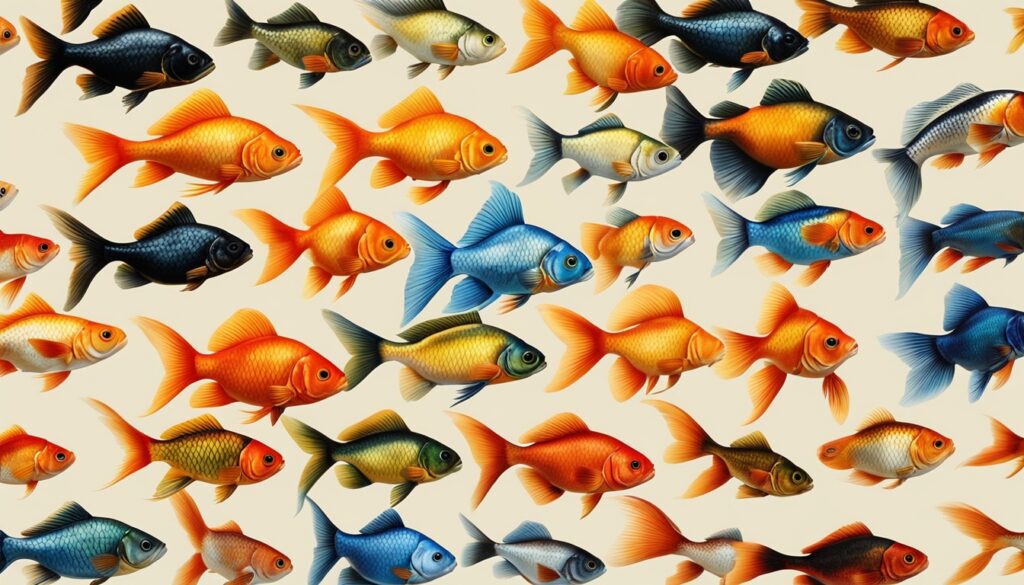
Goldfish lovers enjoy the wide range of colors and types available. But, finding the right goldfish can be both exciting and challenging. Each type has its own look and care needs. We can summarize the goldfish breeds in to three main categories:
1. Common and Comet Goldfish
The common goldfish breeds, like the Comet Goldfish, are known for their toughness. They’re great for outdoor pond fish. These fish can grow big and live over 20 years, so they need a big tank of at least 50 gallons.
Comets are a bit smaller but just as strong. They love to play and come from the United States.
2. Fancy Goldfish Varieties
Fancy goldfish breeds, like Orandas, Ryukins, and Moors, are known for their unique looks. Orandas have a special “wen” or hood that grows as they age. They need special care, including heaters and certain foods.
Ryukins are known for being tough and easy to care for. They have an upturned tail. Black Moor goldfish are also good for beginners. They need careful handling to avoid injuries and stay healthy in their tanks.
3. Exotic and Rare Goldfish Breeds
For those looking for something special, exotic goldfish breeds like Telescope Eye and Bubble Eye goldfish are stunning. They have big eyes and need a calm tank to live well.
These rare goldfish breeds need gentle care to keep their special features safe and healthy.
Goldfish Breeds Average Price List
The price of buying goldfish changes a lot. It depends on how rare they are, how they look, and their size. Here’s a table that shows the average prices for different goldfish breeds. It can help you plan your purchase.
Breed |
Description |
Average Price |
|---|---|---|
Common Goldfish |
Hardy, adaptable, suitable for ponds |
$5 – $15 |
Comet Goldfish |
Active and hearty, smaller than common |
$5 – $20 |
Oranda Goldfish |
Fancy, with distinctive wen growth |
$20 – $50 |
Ryukin Goldfish |
Hardy, with a deep body and high back |
$15 – $45 |
Telescope Eye Goldfish |
Exotic with prominent eyes |
$10 – $100 |
Bubble Eye Goldfish |
Delicate with fluid-filled eye sacs |
$20 – $100 |
Starting your goldfish journey can be exciting. Knowing about each breed will help you create a great home for them. These fish add beauty and peace to your life.
Natural Habitat and Environmental Needs
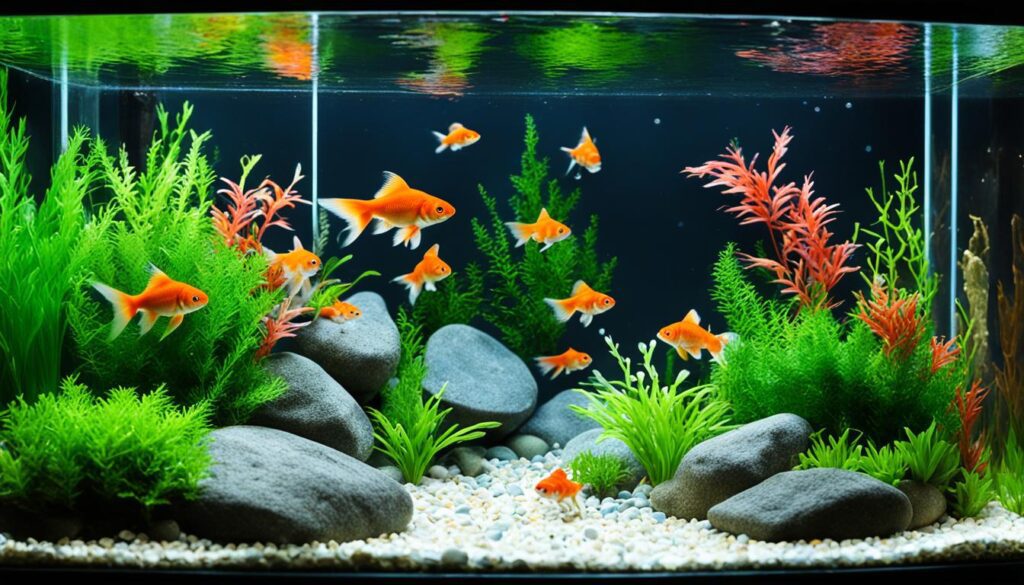
Goldfish are adaptable and hardy, living in many freshwater places like rivers, lakes, and ponds. Knowing their goldfish natural habitat is key to keeping them healthy in tanks or ponds.
Temperate to Tropical: Goldfish in the Wild
Goldfish like temperate freshwater but can also live in tropical areas. They come from Eastern Asia and now live all over the world. They can live in many different places, making them good for ponds and tanks.
Goldfish live in places like streams, lakes, and big reservoirs. They help control mosquitoes, which is good for the environment. They use plants for shelter and to lay eggs, preferring slow-moving waters unlike the small spaces of a goldfish bowl.
Common Myths about Goldfish Habitats
Many myths exist about taking care of goldfish. One big myth is that bowls are good homes for them. Bowls are too small and can’t filter the water well, causing health problems.
People also think goldfish are small and don’t live long. But, goldfish can get big and live a long time if given the right care.
Date |
Location |
Size |
Weight |
|---|---|---|---|
April 2008 |
The Netherlands |
19 inches |
Not specified |
July 2010 |
Poole, England |
16 inches |
5 pounds |
November 2020 |
Greenville, South Carolina |
15 inches |
9 pounds |
Knowing these facts helps clear up goldfish care misconceptions. It helps create a great home for goldfish in tanks or ponds. Taking good care of goldfish means understanding their natural habits and needs.
Water Requirements for Goldfish
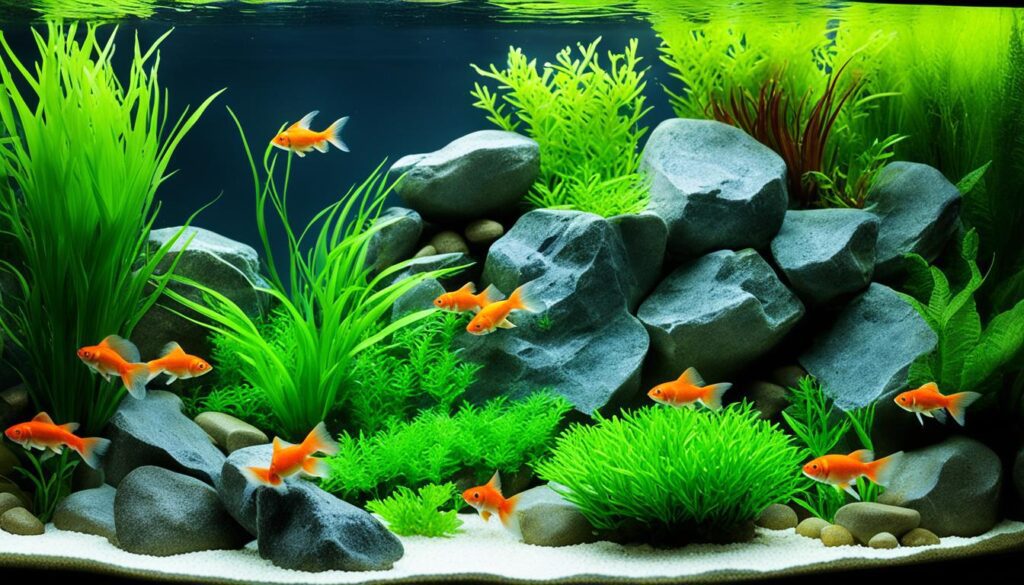
As a goldfish enthusiast, I’ve learned the key to keeping them healthy is top-notch goldfish water quality. It’s not just about clean water; it’s also about the right temperature, pH levels, and water hardness. Let me guide you on how to manage these elements for your goldfish’s well-being.
First, your aquarium water conditions must meet certain standards for your goldfish to stay healthy and live long. The ideal temperature is between 20 to 24°C. Also, pH levels should be kept in a range of 7.0–8.0, slightly alkaline. This helps prevent stress and diseases caused by pH changes.
Testing the water every two weeks is a habit I follow closely. It’s crucial to check for ammonia, nitrite, and nitrate levels. Aim for zero ammonia and nitrite, and keep nitrate under 20 mg/L. This is especially important when setting up a new tank.
For those interested in learning more about goldfish water requirements, here’s a quick guide. Goldfish need strong filtration systems because they produce a lot of waste. They eat a lot and their waste can quickly make the water dirty if not managed well.
Parameter |
Ideal Range |
Comments |
|---|---|---|
Temperature (°C) |
20-24 |
Stable, within narrow limits |
pH |
7.0-8.0 |
Neutral to slightly alkaline |
Ammonia (mg/L) |
0 |
Should always be zero |
Nitrite (mg/L) |
0 |
Should always be zero |
Nitrate (mg/L) |
<20 |
Kept as low as possible |
GH (ppm) |
100-300 |
General hardness |
KH (ppm) |
70-140 |
Carbonate hardness |
How often you change the water affects your aquarium’s health. For a typical goldfish tank, change about 10 to 20% every week. These changes refresh the water and keep the minerals and chemistry balanced. This is key for maintaining water quality for goldfish.
Understanding and keeping the right aquarium water conditions is crucial for your goldfish’s health and happiness. Regular maintenance is key to a happy life for your goldfish in their tank.
Proper Housing and Space Considerations
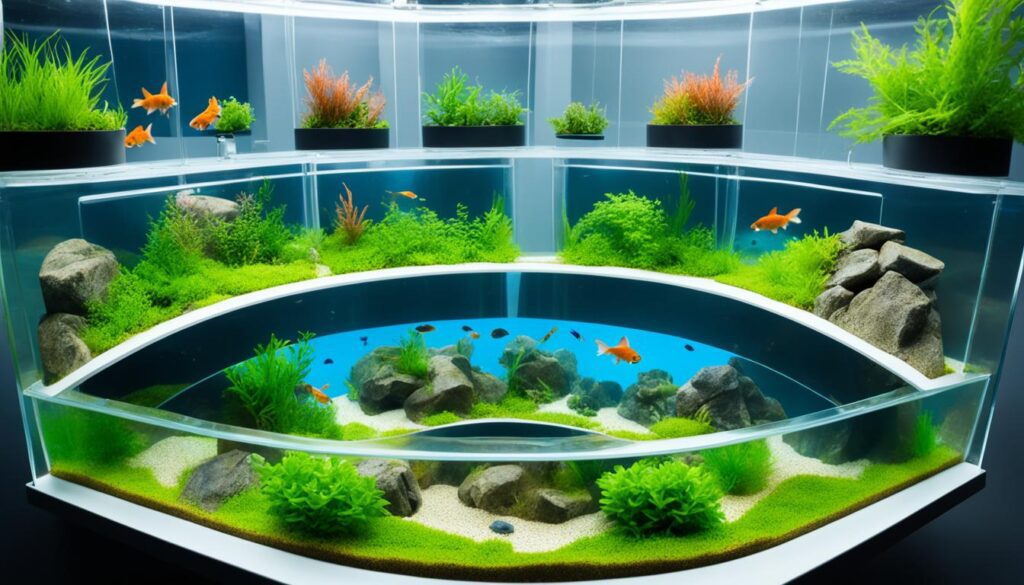
Choosing the right home for your goldfish is a big decision. You can pick between outdoor goldfish ponds or an indoor aquarium. Each option has its own set of care needs and space requirements. Goldfish are more than pets; they need a specific environment to thrive.
From Aquariums to Ponds: Choosing the Right Home
If you’re thinking about an indoor setup, it’s important to know the aquarium size for goldfish. A good rule of thumb is to have at least 20 gallons of water for each adult goldfish. This gives them enough room to swim and grow. Fancy goldfish do well in indoor tanks because you can control the water temperature and keep it clean.
Outdoor goldfish ponds give goldfish a more natural home. They let goldfish act like they would in the wild. But, these ponds need a lot of space and upkeep, especially to handle changes in the weather.
The Issue with Fishbowls and Small Containers
Goldfish bowls are often thought to be a good choice, but they’re not. They’re too small and don’t filter the water well. This leads to a buildup of toxins that can hurt goldfish. It’s important to tell pet owners why small goldfish tanks are not a good idea.
Knowing what goldfish need in terms of space helps you create a good home for them. Here’s a quick guide on how to match your tank to your goldfish’s needs:
Feature |
Requirement |
|---|---|
Minimum Tank Size |
20 gallons per adult goldfish |
Water Temperature |
50-70°F (10-21°C) |
Filtration |
High capacity, frequently monitored |
Water Changes |
30%-50% bi-weekly |
By following these guidelines, you can make sure your goldfish live a happy life. Avoid the problems that come with goldfish bowls harm and small tanks. Always think about what’s best for your goldfish when choosing their home.
Goldfish Breeds Feeding Regimens
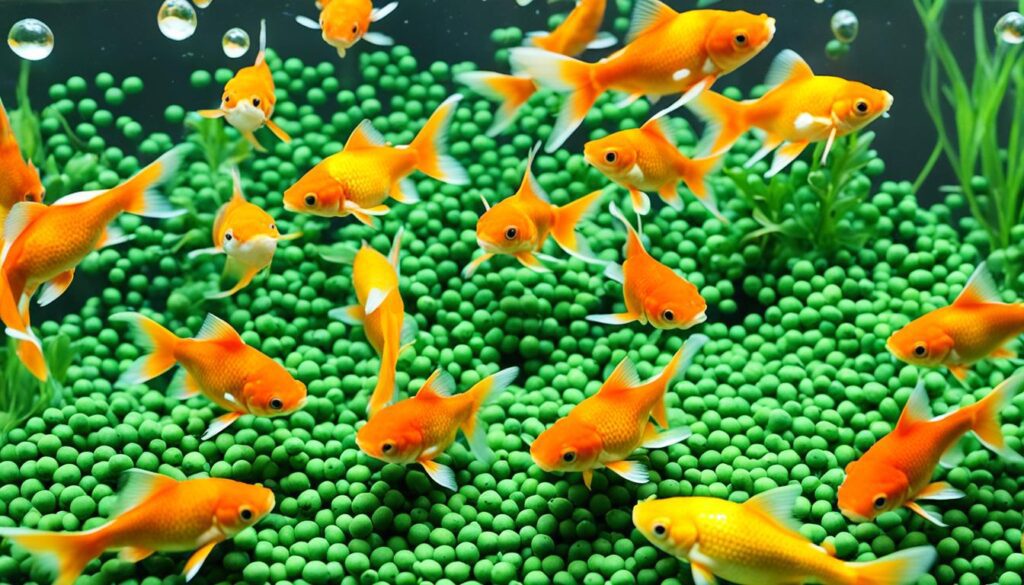
Knowing what goldfish eat is key to keeping them healthy and long-lived. Goldfish are not just pretty fish; they need a special diet because they eat almost anything. Feeding them different types of goldfish food helps them get the nutrients they need.
Dietary Needs of Goldfish
Goldfish eat both plants and animals. They like to graze all day. In tanks, give them sinking pellets to stop them from eating too much. This helps prevent swim bladder problems, especially in fancy goldfish.
Here are some tips for small and fancy goldfish:
- Telescope, Celestial Eye, Fantails, and Pearlscale should eat high-quality pellets made for small goldfish.
- Feed them twice a day, only as much as they can eat in 30 seconds to a minute to avoid waste and keep the water clean.
Feeding them a variety of foods makes their lives richer and meets their needs. Add live foods like brine shrimp or daphnia, and sometimes give them boiled peas or leafy greens.
Common Feeding Mistakes to Avoid
Many people make goldfish feeding mistakes that can hurt their fish. Overfeeding is a big mistake that can harm the fish and make the tank dirty. Here’s how to avoid these mistakes:
- Always measure the food to make sure it’s right for the number and size of your fish.
- Watch how your goldfish eat; change their diet if they don’t seem interested or if food is left over.
It’s not just how much you feed your goldfish that matters, but also the quality and variety of their food. Using these tips will keep the water clean and give your goldfish a healthy diet. This supports their overall health.
Goldfish Type |
Recommended Tank Size |
Feed Type |
Feeding Frequency |
|---|---|---|---|
Fancy Goldfish |
Minimum 30 gallons |
Sinking Pellets |
2 times/day |
Long-bodied Goldfish |
Minimum 50 gallons |
Sinking Pellets |
2 times/day |
Small Varieties (Telescope, etc.) |
Adjust according to size |
Sinking Pellets |
2 times/day |
Understanding your goldfish’s diet is key to a happy aquarium. It ensures your goldfish get the right nutrition and care they need to live well.
Behavior and Compatibility of Goldfish
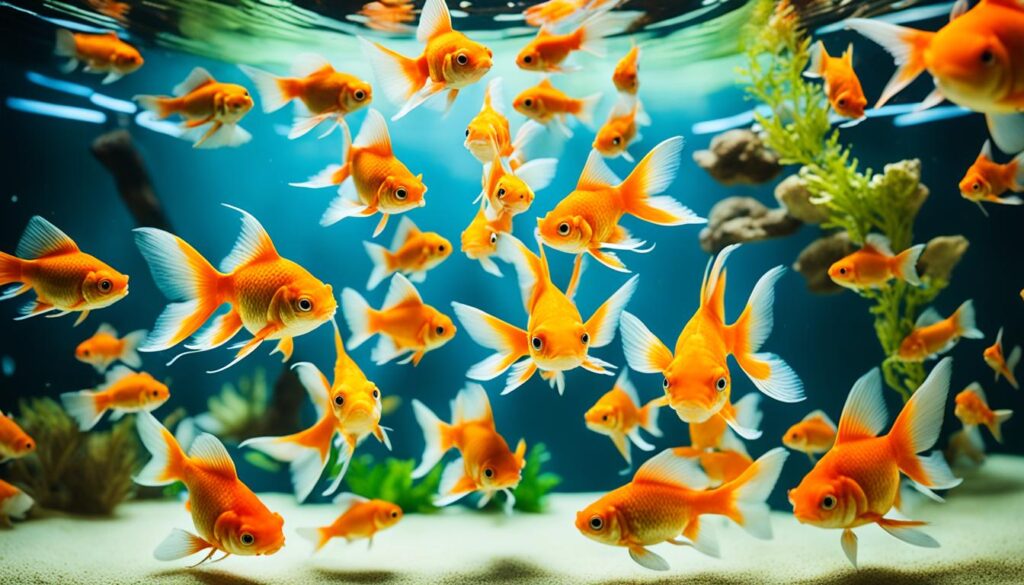
Understanding goldfish behavior, goldfish compatibility, and goldfish socialization is key for those who want to keep these pets together in one tank. Goldfish love being around others of their kind. They do best with tank mates of similar size and temperament.
Goldfish can be messy eaters, which means they create a lot of waste. This can hurt the health of other fish in the tank. It’s important to pick tank mates that like hard, alkaline water and can handle the waste goldfish produce.
Not all goldfish types get along. Some fancy goldfish, like Orandas and Black Moors, need to be kept away from faster fish like Comets or Shubunkins. The faster fish might take all the food, causing stress and health problems for the fancy goldfish. Learn more about mixing goldfish types at this useful link.
Here’s how to mix goldfish in a community tank:
Feature |
Consideration |
|---|---|
Socialization |
Goldfish like being in groups. A single goldfish might get lonely and stressed. |
Compatibility |
Don’t mix slow-moving fancy goldfish with fast ones. They might fight over food. |
Community Tank Setting |
Make sure there’s enough space to stop fish from fighting over food and space. |
Disease Prevention |
Keep an eye on the water quality and quarantine new fish to stop diseases from spreading. |
Bullying |
Watch how fish interact and move fish around or remove the mean ones if needed. |
Adding a third goldfish can help stop bullying between two. Watch how your goldfish act to make sure they’re all happy and healthy. When adding new fish, pick ones that fit well with the goldfish’s needs for a peaceful tank.
Care Guide for Healthy Goldfish

Goldfish care requires focus and regular upkeep of the aquarium. I’m excited to share tips and practices to help your goldfish live well in a safe and happy home.
Regular Maintenance and Water Changes
Keeping your goldfish tank clean is key to a healthy aquarium. A regular water change schedule is crucial. I suggest changing about 20-30% of the tank water each week.
This helps keep harmful substances like ammonia and nitrates low. Using water conditioners when you refill the tank also protects your goldfish from toxins in tap water. This makes their home healthier.
Preventative Health Measures
Preventing health issues goes beyond just clean water. It also means choosing the right tank setup and tankmates. Pick substrates that are gentle on your goldfish, so they can move around safely.
Be careful when choosing other fish for your tank. Some may stress your goldfish or compete for food. Make sure your tank has a secure lid and good filters to keep the water safe and clean.
Starting with the right setup and maintenance can help prevent diseases. Following these tips has kept my goldfish happy and healthy. I hope it does the same for yours!
Goldfish Breeding Practices
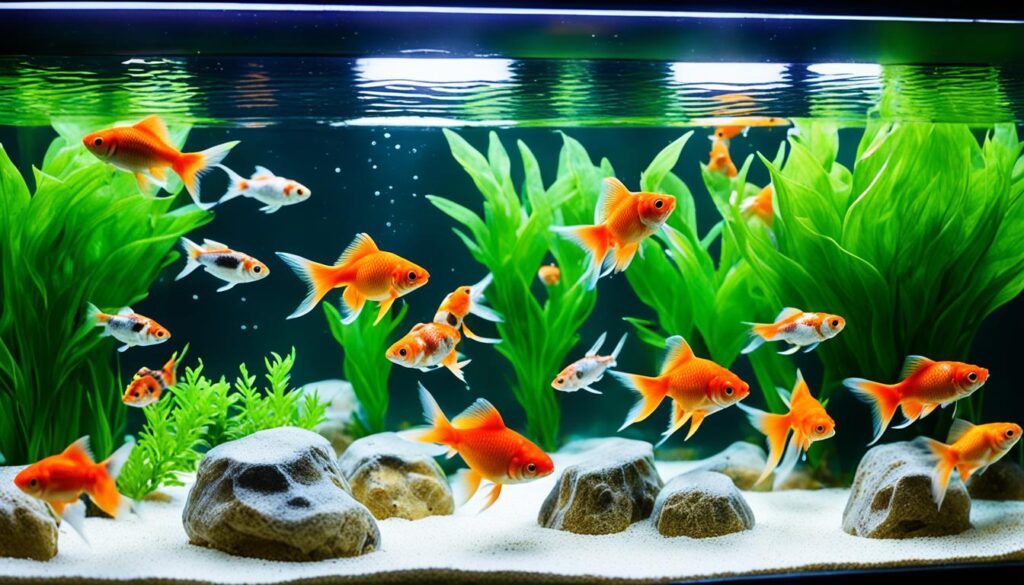
Goldfish breeding is a fascinating subject with many methods and insights. It covers the entire goldfish life cycle. From understanding how goldfish spawn to caring for their young, each step is important.
Reproduction and Spawning in Captivity
Watching goldfish spawn is quite interesting. They usually spawn every 3-4 weeks, depending on the water and their health. Males show off breeding spots and may bother females, which is normal and important.
To avoid too much stress on the females, some use a tank divider in smaller tanks, like a 55-gallon one. Also, changing 10% of the water weekly helps keep the fish healthy for breeding.
Raising Fry: From Eggs to Juveniles
After spawning, caring for the fry is key. The first stages are critical as the eggs hatch and the fry start their life. Since eggs don’t hatch well in a 50-gallon tank, breeders must plan carefully.
Goldfish fry do well in controlled environments with good water and food. Feeding them pellets with 25% protein helps them grow strong.
As the young goldfish grow, how they are raised matters a lot. Techniques like those used in land or floating net systems help them survive and grow. Each method offers unique benefits that affect their health.
Knowing these details improves breeding and helps raise a healthy goldfish colony. This adds beauty and life to any aquarium.
Best Goldfish Breeds for Beginners
Starting with goldfish should be easy and fun. Choose breeds that are tough and easy to care for. These pets can live for over a decade, so picking the right one is key. The Pearlscale is a great choice for beginners because it stays small and looks beautiful.
The Black Moor goldfish is another good pick. It grows black and has big, telescope-like eyes. It’s perfect for both new and experienced fish keepers. The Shubunkin and Comet goldfish are also great for beginners. They are colorful, hardy, and have beautiful tails.
Choosing any goldfish breed is a great way to learn and enjoy. You can watch the Ryukin grow up to 10 inches or see the Oranda’s unique wen. The Bubble Eye goldfish looks special and is worth the extra care. With the right breed, goldfish keeping can be fun and easy for beginners.








